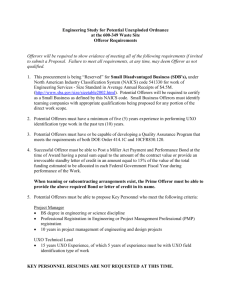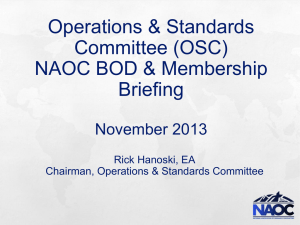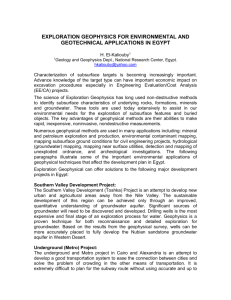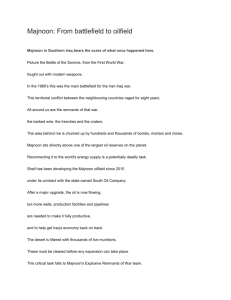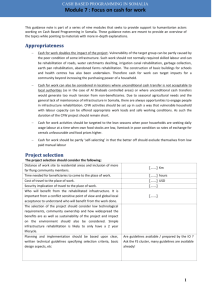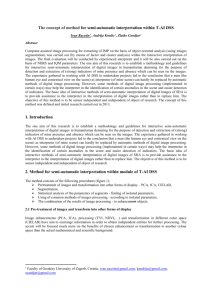the Dept. of Defense UXO Report to Congress
advertisement
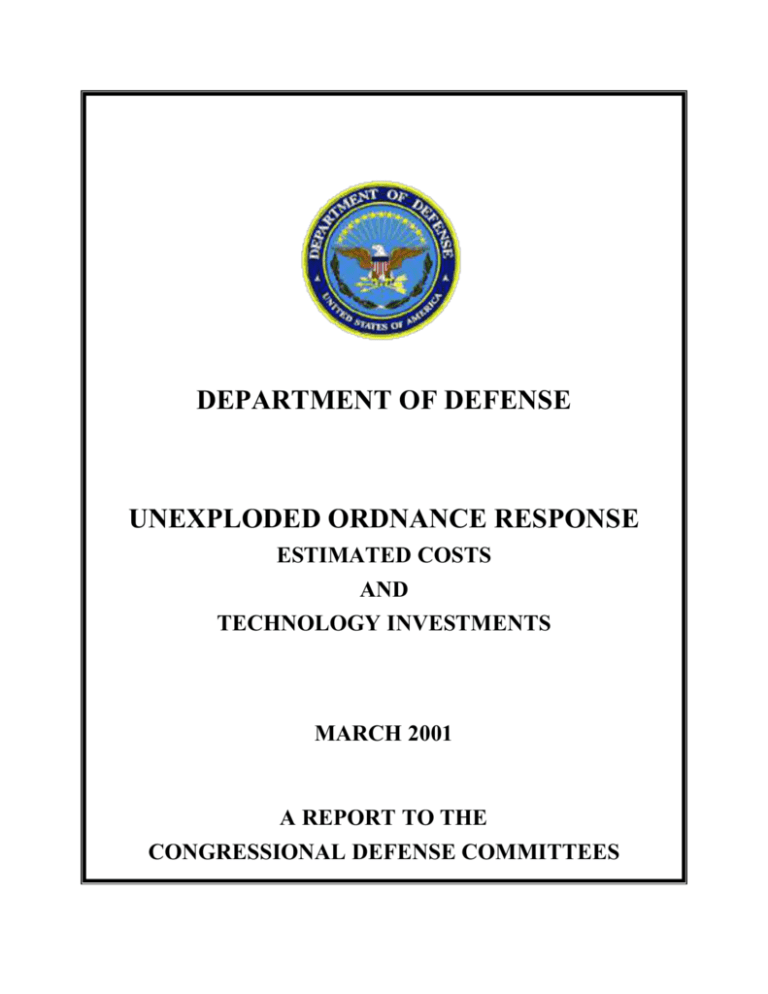
DEPARTMENT OF DEFENSE UNEXPLODED ORDNANCE RESPONSE ESTIMATED COSTS AND TECHNOLOGY INVESTMENTS MARCH 2001 A REPORT TO THE CONGRESSIONAL DEFENSE COMMITTEES EXECUTIVE SUMMARY One result of decades of military training and testing of weapons systems is the presence of unexploded ordnance (UXO), which are munitions that have not functioned or fully detonated as designed. The presence of UXO requires the conduct of a UXO response to ensure that ranges that are closed, transferring from Department of Defense (DoD) control, or that are already transferred from DoD control can be safely put to other uses. The Committee on Armed Services, United States Senate, requested that DoD submit an estimate of the current and projected costs for UXO responses and identify plans for UXO response technology development. This initial report and follow on reports will address this issue. In this initial report, DoD estimated only the costs associated with responses to remove UXO from closed, transferring, or transferred (CTT) ranges. The estimates do not address costs associated with: The routine management of active and inactive ranges (Ongoing range management practices at active and inactive ranges, including periodic clearance of UXO, are not addressed in this report, but represent an important part of DoD’s overall UXO and range management efforts. The Services budget for the costs associated with the management of the military’s active and inactive ranges on an annual basis); UXO responses at active or inactive ranges (UXO response costs are typically incurred when a range is closed or transferring from DoD control); UXO responses at other areas where UXO may be present (e.g., water ranges, historical battlefields); and DoD’s FY 2000 Financial Statements provide estimates of the potential liability associated with UXO clean-up costs at closed, transferred and transferring ranges to be $14 billion. The DoD Components developed the estimates using a variety of methods available for use at the time of financial statement preparations. The Department is developing a unique UXO modeling and simulation methodology conforming to DoD Instruction 5000.61 “DoD Modeling and Simulation Verification, Validation, And Accreditation.” The Department plans to complete and publish the new methodology in FY 2001 for use in the preparation of the FY 2001 Financial Statements. These estimates will also be included in the Defense Environmental Restoration Program Annual Report to be submitted in March 2002. This report also outlines the Department’s UXO response technology investment strategy. Technology discovery and development may lead to increased effectiveness and efficiencies in UXO responses. The UXO response technology investment strategy anticipates demonstrable advances in capabilities across the spectrum of UXO technologies. The Department will continue to assess and evaluate emergent technologies and the investment strategy for impact across all phases of the UXO response process. 1 1.0 INTRODUCTION The Fiscal Year 2000 Committee on Armed Services, United States Senate, Report 106-50, pages 291–293, accompanying the National Defense Authorization Act for Fiscal Year 2000 (Public Law 106-65), included a discussion entitled “Research and development to support unexploded ordnance clearance, active range unexploded ordnance clearance, and explosive ordnance disposal.” In response to the request in this section of the Committee’s Report, the Department of Defense (DoD) is providing an evaluation of the costs and technologies associated with conducting unexploded ordnance (UXO) responses at ranges that are closed, transferring from DoD control, or that have already been transferred from DoD control.1 1.1 CONTENTS OF THIS REPORT In this initial report, DoD estimated only the costs associated with responses to remove UXO from closed, transferring, or transferred (CTT) ranges. The estimates do not address costs associated with: The routine management of active and inactive ranges (including UXO clearance in support of range operations) 2; UXO responses at active or inactive ranges; UXO responses at other areas where UXO may be present (e.g., water ranges, historical battlefields); and This report also discusses DoD’s UXO response technology investments, provides information regarding the obligation and expenditure of funds for UXO response technology research, development, test, and evaluation (RDT&E) efforts, and evaluates the applicability of Section 349 of the National Defense Authorization Act for Fiscal Year 1998 (Public Law 105-85). For purposes of this report, the term “UXO response” is used rather than the term “UXO remediation.” The term “UXO response” describes the full range of options to achieve protection of human health and the environment, while providing for explosives safety. 1 2 Ongoing range management practices at active and inactive ranges, including periodic clearance of UXO, are not addressed in this report, but represent an important part of DoD’s overall UXO and range management efforts. The Services budget for the costs associated with the management of the military’s active and inactive ranges on an annual basis. 2 2.0 COST ESTIMATES FOR UNEXPLODED ORDNANCE RESPONSES DoD’s FY 2000 Financial Statements provide estimates of the potential liability associated with UXO clean-up costs at closed, transferring and transferred ranges to be $14 billion. DoD does not estimate UXO cleanup costs for active and inactive ranges unless constituents on those ranges are a danger to human health and the environment (e.g., contaminating an aquifer). The removal of ordnance to maintain safe access to active and inactive ranges, and maintain a buffer zone to mitigate encroachment is an ongoing maintenance expense (covered by Operations and Maintenance funds). In accordance with Federal accounting standards, these expenses are not accrued as a liability except in those few specific instances where environmental response actions - beyond what is necessary to keep the range in operation - are probable and the costs of such a response are measurable. The $14 billion estimate provided in the DoD Financial Statements is the best estimate available in FY 2000. The FY 2000 Financial Statements provide the Department’s initial estimate for UXO cleanup costs. As described in the Financial Statements, the Army, Navy and Air Force used a variety of different sources and models to develop their estimates. The Army used a combination of broad assumptions (used in preliminary regulatory impact analysis) and the Remedial Action Cost Engineering Requirements (RACER) cost estimating tool. The Navy and Air Force estimates used broad assumptions derived from preliminary regulatory impact analysis efforts. None of these estimates is comprehensive or based on a standard cost estimating methodology. DoD is in the process of developing a consistent, standardized and defensible cost estimation methodology. One of the first steps is independent validation of the RACER cost-estimating tool. Additional steps include: completing a comprehensive inventory of all DoD ranges, determining what standards of UXO response to use (e.g., what are the appropriate land use controls), estimating the percentage of each range that is likely to contain contamination, and developing a better scientific understanding of how chemical constituents of ordnance contaminate soil and water. DoD will use improved and validated cost estimating methods to prepare the FY 2001 Financial Statements and also will include the estimates in the Defense Environmental Restoration Program Annual Report to be submitted in March 2002. Over the next few years the Department’s research efforts will help DoD better understand how chemical constituents contaminate soil and water. DoD will use this research to further refine its cost estimates and provide these refined estimates in subsequent Financial Statements and annual reports. 3 3.0 UXO RESPONSE TECHNOLOGY INVESTMENT In response to the complex challenges associated with conducting UXO responses, the Department plans to continue its significant investment in advancing the state of UXO response technology. This focused effort has already resulted in significant technological advances in the last several years. 3.1 GOALS OF THE UXO RESPONSE TECHNOLOGY INVESTMENT STRATEGY The Department faces a number of complex scientific and technological challenges in conducting responses at sites potentially containing munitions or UXO.3 For example, field experience indicates that a high percentage (i.e., as much as 99%) of the objects found in the course of a UXO response are non-hazardous metal items. As a result, a significant portion of the cost of a UXO response stems from excavating these non-hazardous items. To address this specific challenge, the Department continues to make focused investments aimed at improving both the understanding of the underlying geophysics and advancing the capabilities of specific systems used in conducting UXO responses. In general, the principle goals and developmental objectives for the Department’s continuing investment in advancing the state of UXO response technology are to: 3.2 Improve the understanding of the underlying science of UXO response technologies (e.g., geophysics), Develop more effective and efficient technologies for conducting UXO responses, Significantly increase the probability of UXO detection while significantly reducing the “false alarm” rate, Increase the applicability of these systems to a more diverse set of geographic applications, and Contribute to overall cost effectiveness. INVESTMENT OVERSIGHT The Office of the Secretary of Defense (OSD) and various Army offices oversee the Department’s UXO response technology investment strategy. The two principal OSD investment programs are the Strategic Environmental Research and Development Program (SERDP) and the Environmental Security Technology Certification Program (ESTCP). These programs work with the Services, various regulatory agencies, industry representatives, leading universities, government and corporate research laboratories, and other stakeholders to determine specific areas for investment. The DoD offices overseeing and implementing the UXO response technology investment strategy also work closely with the Joint Unexploded Ordnance Coordination Office (JUXOCO), to coordinate and leverage investments in UXO response technology with investments occurring 3 The investment strategy described herein does not address technology issues related to active and inactive range management, remediation of other constituent contamination, or UXO responses at active or inactive ranges and water ranges. 4 in related mission areas. Through this interaction, the Department seeks to increase the overall return on investment. 3.3 PAST INVESTMENTS The many advancements in UXO response technology since the early 1990’s are a direct result of the Department’s significantly increased investment in this area. These investments were not only in the “hardware” that is used for UXO responses; the Department has also undertaken steps to: Increase the understanding of many of the underlying geophysical parameters, Develop better means to measure the effectiveness of UXO response systems, and Demonstrate the effectiveness and examine means to optimize the performance of these systems. 3.3.1 UXO Response Technology Investments, 1995 to Present Prior to FY 1995, the Department was not making focused investments to address the technical challenges unique to UXO responses. Recognizing that UXO response was an emerging priority requirement, in FY 1995 and FY 1996 DoD invested approximately $6 million in Program 4 Definition and Risk Reduction (PDRR) to demonstrate, validate, and improve commercially available technologies. These efforts resulted in significant advances and have led to the increasing use of digital geophysical methods in UXO responses. In FY 1995, the Department also initiated development of a longer-term science and technology (S&T) investment strategy in support of UXO responses. Over the ensuing years, S&T investments increased to approximately $4 million a year. As the Department’s S&T investments progressed, the funding for PDRR efforts also increased to address emerging technologies. In addition, in FY 1997 the Department conducted a series of UXO technology demonstrations at Jefferson Proving Ground, IN. Figure 3.1 summarizes the UXO response technology investments from FY 1995 through FY 2000. 4 For purposes of this report, PDRR is the equivalent of demonstration/validation (Dem/Val) of UXO response technologies. It should also be noted that effective 23 October 2000 the term “PDRR” has been incorporated into “System Development Demonstration” (see DoD Instruction 5000.2). 5 9,000 JPG Demonstration PDRR (Dem/Val) 8,000 S&T 7,000 Funding ($K) 6,000 5,000 4,000 3,000 2,000 1,000 0 FY95 FY96 FY97 FY98 FY99 FY00 Figure 3.1 UXO Response RDT&E Investments (FY 1995 to FY 2000) 3.3.2 Obligations and Expenditures, FY 1995 to Present Information on obligation and expenditures related to the Department’s UXO response technology investments from FY1995 to December 2000 are provided in Appendix B. 3.4 THE WAY AHEAD The Department established six technology objectives for the UXO response technology investment strategy. These objectives are: Wide area assessment, Production ground survey, Cued identification, Standards and protocols, Recovery and treatment, and Hazard assessment. These technology objectives seek to improve either “hardware” capabilities (e.g., sensors and platforms) or to advance “software” capabilities (e.g., signal processing algorithms) to improve the ability to conduct effective responses at sites where UXO may be present. Additional information on these technology objectives is provided in Appendix C. 3.5 IMPACT OF INVESTMENTS IN UXO RESPONSE TECHNOLOGY While the Department’s investments in UXO response technology resulted in significant advances since 1995, the largest impact of technology will be seen in the future. Improved site characterization technologies should have a significant impact on the overall effectiveness of 6 UXO responses. This objective represents the highest priority requirement and is the focus of the majority of the Department’s investment in UXO response technology. Ground-based digital geophysical mapping (DGM) will continue to improve and will continue to improve the overall effectiveness and confidence the Department and other stakeholders have in the responses that are being conducted. Improved recovery and treatment systems will improve the efficiency, safety, and overall protectiveness of responses. The DoD will continue to assess and evaluate emergent technologies and the investment strategy for impact across all phases of the UXO response process. 3.6 APPLICABILITY OF SECTION 349 Under Section 349 of the National Defense Authorization Act for Fiscal Year 1998 (Public Law 105-85) (see Appendix D), Congress provided DoD the authority to enter into partnerships with private entities to demonstrate and validate environmental technologies. In accordance with the request for this report, DoD has evaluated the applicability of this authority to DoD’s UXO response technology investment strategy. To date, other existing authorities to enter into contracts, grants, and cooperative agreements have proved sufficient to fully and effectively execute the UXO response technology investment strategy. 3.7 TRANSITIONING TECHNOLOGY TO THE END USER To successfully impact future UXO response activities, investments in UXO response technology must result in successful transfer of these new technologies to the end users (i.e., private industry and DoD UXO response managers). For these new technologies to be deployed the systems must be available to the contractors who perform the bulk of the UXO response work and must be proven effective to ensure that the broad community of stakeholders understand the use of newly developed technologies. Currently DoD is examining various challenges related to the effective transition of UXO response technologies to the end users. 7 4.0 SUMMARY This report provides information on two specific areas of DoD’s UXO response program: The estimated costs associated with UXO responses at closed, transferring, and transferred ranges, and Investment in the development of technologies that support UXO responses. DoD is working to develop a program to effectively manage UXO responses. Key areas being addressed include: Policy: Developing effective and timely directives, instructions, guidance, and strategies to improve UXO responses. Budget Guidance: Providing appropriate resources and planning direction to improve UXO responses. Representation and Communication: Establishing and maintaining effective communication with Congress, other Federal agencies, the States, Tribes, local governments, and the public. Technology: Encouraging investment in development of new UXO response technologies and timely application of new technology in UXO responses. 8 APPENDIX A: LIST OF ACRONYMS CTT Dem/Val DERP DGM DoD EMI EOD ESTCP FUDS FY GPR JPG JUXOCO OSD PDRR RACER RDT&E S&T SECDEF SERDP USC UXO Closed, Transferred, and Transferring Demonstration/Validation Defense Environmental Restoration Program Digital Geophysical Mapping Department of Defense Electromagnetic Induction Explosive Ordnance Disposal Environmental Security Technology Certification Program Formerly Used Defense Sites Fiscal Year Ground Penetrating Radar Jefferson Proving Ground Joint Unexploded Ordnance Coordination Office Office of the Secretary of Defense Program Definition and Risk Reduction Remedial Action Cost Engineering Requirements Research, Development, Test, and Evaluation Science and Technology Secretary of Defense Strategic Environmental Research and Development Program United States Code Unexploded Ordnance 9 Appendix B: Obligations and Expenditures This table provides information on the obligation and expenditures related to the Department’s UXO response technology investments from FY1995 up through December 2000. Program Element FY95 Total Funding ($K) Obl. FY96 Exp. Total Funding ($K) Obl. FY97 Exp. Total Funding ($K) Obl. FY98 Exp. PE: 601101A PE: 601102A 80 100% 100% 50 100% 100% PE: 602720A FY99 Total Funding ($K) Obl. Exp. 105 100% 100% Total Funding ($K) Obl. FY00 Exp. Total Funding ($K) Obl. Exp. 220 100% 100% 675 100% 100% 525 100% 100% 300 100% 71% 3,821 100% 100% 745 100% 100% 1,220 100% 100% 1,400 100% 94% PE: 603716D 100 100% 100% 300 100% 100% 1,335 100% 100% 2,515 100% 100% 3,642 100% 100% 2,446 100% 90% PE: 603851D 3,634 100% 100% 1,544 100% 100% 400 100% 100% 625 100% 100% 1,355 100% 100% 4,084 100% 85% 10 APPENDIX C: TECHNOLOGY OBJECTIVES. Figures C.1 to C.6 provide a brief synopsis of these investment areas describing the: objectives, needs, benefits, system requirements, plan for future actions, and technology roadmap. FIGURE C.1: INVESTMENT IN WIDE AREA ASSESSMENT Objective Need Benefit Required System Capabilities Future Plan Development of capabilities to perform rapid initial assessment of large areas Systems to locate concentrations of UXO to focus areas for subsequent production ground surveys Identification of lands where UXO is not present may reduce the area subject to detailed site characterization May allow for more rapid responses in support of reuse of these lands Ability to detect wide variety of UXO types, sizes, and shapes Operation in varying terrain, vegetative cover, and geology Areal coverage rates exceeding hundreds of acres per day Detection of both surface and sub-surface UXO Low resolution capability to quickly determine boundaries for more subsequent detailed investigation High resolution capability to locate individual UXO Moderate to high probability of detection Moderate discrimination capability to minimize false alarm rate Exploiting improved signal processing and optimizing platform designs Transition both magnetic and electromagnetic capabilities to survey large tracts of open and flat terrain Extend capability to rough and vegetative terrain Investment Roadmap FY00 FY01 FY02 FY03 FY04 FY05 FY06 FY07 SAR Phenomenology S&T Platform/Sensor Development Mag/EMI Signal Process For Open Flat Terrain For Rough and Vegetative Terrain Mag and EMI systems DEM/VAL DEM/VAL SAR Assessment 11 FIGURE C.2: INVESTMENT IN PRODUCTION GROUND SURVEY Objective Need Benefit Required System Capabilities Future Plan Improve existing and/or develop new capabilities for detailed site characterization Systems to accurately detect individual UXO and discriminate UXO from non-hazardous items Creation of permanent, accurate geo-referenced data sets Increasing system capabilities with respect to probability of detection and discrimination, coverage rates, and applicability to varying terrain and geology improves confidence in site characterization and may reduce costs Ability to detect wide variety of UXO types, sizes, and shapes Operation in varying terrain, vegetative cover, and geology Areal coverage rates exceeding tens of acres per day (vehicle mounted) or acres per day (man portable) Detection of both surface and sub-surface UXO High resolution capability to locate individual UXO and discriminate from non-UXO items High probability of detection High discrimination capability to minimize false alarm rate Improving understanding of the phenomenology of sensor responses to UXO and clutter, advanced modeling, and signal processing Gather UXO and non-UXO signature data from a wide variety of sensors (e.g., EMI sensors, magnetometers, radar, acoustic sensors) Couple production ground survey sensors and signal processes and platform advances with advanced geophysical modeling capabilities Investment Roadmap FY00 FY01 FY02 FY03 FY04 FY05 FY06 FY07 Signature Phenomenology S&T Modeling Signal Processing Advanced Sensor Development Man Portable and Vehicle Systems DEM/VAL Advanced Discrimination 12 Next Generation Systems FIGURE C.3: INVESTMENT IN CUED IDENTIFICATION Objective Need Benefit Required System Capabilities Future Plan Develop capabilities for non-intrusive, cost-effective cued object identification Systems to determine whether ordnance objects pose explosive hazards Provide additional capability to characterize detected anomalies Improves ability to assess explosive hazards Allows for refined analysis of alternatives to address UXO Offers opportunity to reducing unneeded excavation No search capability is required as sensor is cued Throughput of tens to hundreds of objects per day Ability to interrogate sub-surface or partially exposed items Very high discrimination capability as high confidence is needed in determinations of “not ordnance” Ability to identify ordnance type (e.g., high explosive, pyrotechnic) Initial work conducted to investigate the trace chemical signature associated with a UXO was terminated because other systems have shown potential to identify the filler directly Demonstration of a variety of other cued identification techniques (e.g., neutron activation, acoustics) Development of next generation systems for partially exposed or subsurface UXO Demonstration of ground penetrating radar discrimination Investment Roadmap FY00 FY01 FY02 FY03 FY04 FY05 FY06 FY07 Chemical Signatures S&T Advanced Identification Radar Phenomenology Open Terrain and Large Ordnance Cued GPR DEM/VAL Advanced Identification Object Identification Exposed Objects 13 FIGURE C.4: INVESTMENT IN STANDARDS AND PROTOCOLS Objective Need Benefit Required System Capabilities Future Plan To develop methods for collection and management of standardized, high quality archival data Advances in supporting technologies and the development of technical standards and protocols to support subsequent analysis, actions, QA/QC, and review by stakeholders Standardized data collection and management improves confidence in response activities, improves legal defensibility, allows for reevaluation, and improves ability to evaluate data over time Must accommodate systems that operate in a variety of terrain and vegetation, using different navigation/geo-location systems Ensure collected data meets performance requirements Advanced cost-effective geo-location technologies that can operate in varying terrain and vegetation and provide for highly accurate registration of sensor data Standard software and visualization tools to assist stakeholder understanding of analyses and decisions Standards for data archiving Standardized technology test sites and protocols Improve geo-location technology for terrain where differential global positioning satellite (GPS) access is unavailable Transition data management standards and protocols to the “user” communities Continue effort to develop and transition standards, protocols, and software for data management Investment Roadmap FY00 FY01 FY02 FY03 FY04 FY05 FY06 Algorithm Development S&T Data Analysis Platform Data Standards/Protocols DEM/VAL Geo-Location Standardized UXO Demonstration Sites 14 FY07 FIGURE C.5: INVESTMENT IN RECOVERY AND TREATMENT Objective Need Benefit Required System Capabilities Future Plan To develop capabilities to reduce the cost and environmental impact associated with UXO recovery and treatment Improved removal and treatment systems are required to efficiently, safely, and effectively recover and treat individual UXO as well as for mass recovery in areas densely populated with UXO Greater safety and efficiency of UXO recovery operations Reduced environmental impact Increased regulatory and stakeholder acceptance Recovery Ability to recover individual UXO Ability to conduct mass UXO recovery Systems may need either standoff capability (e.g., remote operation) or robust design to protect operators Treatment Ability to handle full range of potential UXO items Transportability Regulatory compliance and regulatory agency and stakeholder acceptance Continue to develop and demonstrate technologies for UXO recovery and treatment Investment Roadmap FY00 FY01 FY02 FY03 FY04 FY05 FY06 Advanced Area Clearance S&T Standoff Destruction DEM/VAL Area Clearance Assessment 15 Advanced Area Clearance FY07 FIGURE C.6: INVESTMENT IN HAZARD ASSESSMENT Objective Need Benefit Required System Capabilities Future Plan To develop capabilities to assess and quantify explosives hazards Systems to assess the hazards presented by UXO prior to, during, and after a response The ability to quantify the hazards associated with UXO is a required component in making informed, defensible decisions The ability to assess the hazard presented by UXO, its potential to migrate, and the effectiveness of potential management actions Statistically defensible procedures to assess sites through sub-sampling techniques that reflect the unique aspects of UXO and account for such factors as lateral and vertical distribution The ability to assess the potential for future exposure and effectiveness of potential response actions Development of tools to support the appropriate statistical sampling of sites suspected to contain UXO Investment Roadmap FY00 FY01 FY02 FY03 FY04 FY05 Statistical Sampling S&T For Characterizing Large Sites DEM/VAL Statistical Sampling 16 FY06 FY07 APPENDIX D: SECTION 349 PARTNERSHIPS FOR INVESTMENT IN INNOVATIVE ENVIRONMENTAL TECHNOLOGIES (EXCERPT FROM PUBLIC LAW 105-85) SEC. 349 PARTNERSHIPS FOR INVESTMENT IN INNOVATIVE ENVIRONMENTAL TECHNOLOGIES (a) Authority.--Subject to subsection (b), the Secretary of Defense may enter into a partnership with one or more private entities to demonstrate and validate innovative environmental technologies. (b) Limitations.--The Secretary of Defense may enter into a partnership with respect to an environmental technology under subsection (a) only if-(1) any private entities participating in the partnership are selected through the use of competitive procedures; (2) the partnership provides for parties other than the Department of Defense to provide at least 50 percent of the funding required (not including in-kind contributions or preexisting investments); and (3) the Secretary determines that— (A) the technology has clear potential to be of significant value to the Department of Defense in its environmental remediation activities at a substantial number of Department of Defense sites; and (B) the technology would not be developed without the commitment of Department of Defense funds. (c) Evaluation Guidelines.--Before entering into a partnership with respect to an environmental technology under subsection (a), the Secretary of Defense shall give consideration to the following: (1) The potential for the technology to be used by the Department of Defense for environmental remediation. (2) The technical feasibility and maturity of the technology. (3) The adequacy of financial and management plans to demonstrate and validate the technology. (4) The costs and benefits to the Department of Defense of developing and using the technology. (5) The potential for commercialization of the technology. (6) The proposed arrangements for sharing the costs of the partnership through the use of resources outside the Department of Defense. (d) Funding.--Under a partnership entered into under subsection (a), the Secretary of Defense may provide funds to the partner or partners from appropriations available to the Department of Defense for environmental activities, for a period of up to five years. (e) Report.--In the annual report required under section 2706(a) of title 10, United States Code, the Secretary of Defense shall include the following information with respect to partnerships entered into under this section: (1) The number of such partnerships. (2) A description of the nature of the technology involved in each such partnership. (3) A list of all partners in such partnerships. (f) Coordination.--The Secretary of Defense shall ensure that the Department of Defense coordinates with the Administrator of the Environmental Protection Agency in any verification sponsored by the Department of technologies demonstrated and validated by a partnership entered into under this section. (g) Procedures.--The Secretary of Defense shall develop appropriate procedures to ensure that all Department of Defense funds committed to a partnership entered into under this section are expended for the purpose authorized in the partnership agreement. The Secretary may not enter into a partnership under this section until 30 days after the date on which a copy of such procedures is provided to the Committee on Armed Services of the Senate and the Committee on National Security of the House of Representatives. (h) Termination of Authority.--The authority to enter into agreements under subsection (a) shall terminate three years after the date of the enactment of this Act. 17 REFERENCES Committee on Armed Services, United States Senate, Report 106-50, National Defense Authorization Act for Fiscal Year 2000, May 17, 1999. Research and Development to Support UXO Clearance, Active Range UXO Clearance, and Explosive Ordnance Disposal. Defense Environmental Restoration Program Annual Report to Congress, FY 1999. DoD 6055.9-STD – Ammunition and Explosives Safety Standards Report of the Defense Science Board Task Force Active Range UXO Clearance, and Explosive Ordnance Disposal Programs. April 1998. Section 349 (Public Law 105-85), Partnerships for Investment in Innovative Environmental Technologies. UXO Center of Excellence Annual Report for 1999, Joint Unexploded Ordnance Coordination Office (JUXOCO), 5 April 2000. 18 19
